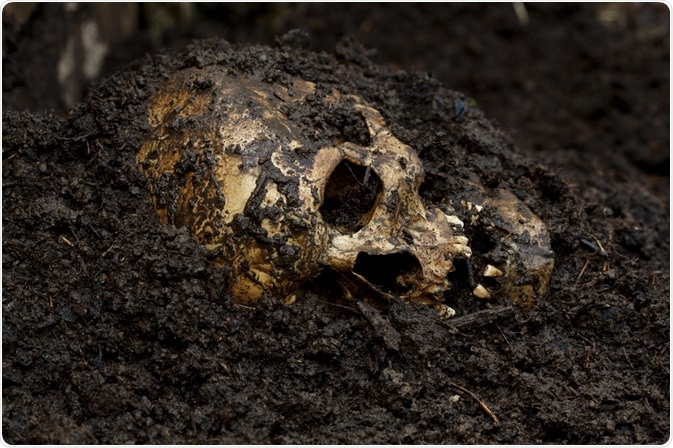Bones can be very useful for extracting forensically relevant information. In the case of mass disasters, for example, the identification of human remains may end up being a long and arduous procedure, therefore the effect the soil has on the bones along with the local microclimate can make a great difference in the information that can be teased out from bones.

Skull buried in soil. Image Credit: Lipowski Milan/Shutterstock.com
Bone Composition
Bones are essentially an inorganic matrix with an organic phase as they consist of hydroxyapatite crystals, collagenous proteins, and a smaller part of non-collagenous proteins, proteoglycans, and lipids. The non-collagenous proteins and proteoglycans have the ability to bind with the hydroxyapatite crystals. This interaction facilitates the preservation of proteins to the point where the proteins can be preserved even in archaeological remains.
Soil and Environmental Considerations with Regards to Bone Diagenesis
There have been many studies investigating the diagenetic trajectory of fossil bones, but the majority of them have been conducted on open-air sites. An older study by Bocherens et al. on the Chauvet Paleolithic cave demonstrated that the preservation of bones that were in contact with the floor cave varied widely probably due to different conditions on that part of the cave. Caves and catacombs are expected to aid the preservation of bones due to their thermal stability when compared to their open-air counterparts.
On the other hand, the aggregation of corpses in a confined space over a relatively short time frame could potentially lower the pH of the local soil to an extent that it can speed up the decomposition of (human) bones.
A study by K.Salesse et al. attempted to describe the diagenetic trajectory of 128 human bone samples originating from six different burial chambers of St. Peter and Marcellinus catacomb in Rome. Their results showcased that the heterogeneity of bone preservation was not randomly distributed within the catacomb; the bones samples were better preserved in the large chambers compared to the smaller ones. This phenomenon might be explained by the combination of acidic conditions along with the condensation of air humidity and runoff against the walls that are all more prevalent in the smaller chambers.
Despite that finding, however, the relatively stable climatic conditions of the catacombs seem to overall favor bone preservation compared to open-air contemporary sites.
Post Mortem Interval Determination and Soil Interaction
The post mortem interval can be determined from bones by assessing the extent of the cracks and delamination of bones that have been exposed to the open air. The weathering of bones, apart from being time-dependent, can be affected by the vegetation of the soil, temperature, humidity, and insect activity. The color-changing of bones is another parameter that can be useful, however, it is strongly influenced by other factors, and one of them is the soil type with which the bones were in contact.
The mineral composition of the soil along with its organic contents affects the preservation of bones. Another route that has been studied recently is the molecular taphonomic one. The levels of DNA preservation can provide information about the post mortem interval. This is done by assessing the levels of DNA preservation in bones that are associated with very long post mortem intervals and using them as a reference point. This approach, however, is still subject to soil geochemistry, depth of burial, and environmental factors.
Obtaining Forensically Relevant Information
Many recent studies have focused on applying visualization methods to investigate the post mortem intervals of bone samples, which include: IR microscopy imaging, tomography coupled with X-ray mapping, and fluorescence spectroscopy. The current challenge, however, is that these techniques are able to discern between forensic and archaeological samples, but are unable to accurately determine post mortem intervals within the range of weeks to months.
To address this knowledge gap, Procopio et al. conducted the first proteomic study on simulated forensic bone specimens buried in the soil of neutral pH. The main point of focus was to look for specific biomarkers that can potentially help to estimate the post mortem interval. In their results, proteome changes were observed occurring within the first four months post-mortem. After the four-month mark, proteins decayed at a slower rate.
Additionally, a statistically significant correlation between the increase of asparagine deamidations in biglycan and the increase of post mortem interval was found. This finding may also become a new biomarker for identifying specific post mortem intervals ranging between one to six months.
Next Steps
New studies are required to better assess how bones decay, by taking into consideration different types of soil, different depth of burials, and the impact of environmental conditions, when it comes to using proteomics to determine the post mortem interval.
Lastly, it has also been shown that bone samples can be heated to 1000°C to emulate the degradation that occurs naturally on aged buried bone samples. By using this approach DNA recovery on simulated older samples can be looked into closely and potentially be improved, leading to even identification of fragmented remains.
Further Reading
Last Updated: Jul 20, 2021